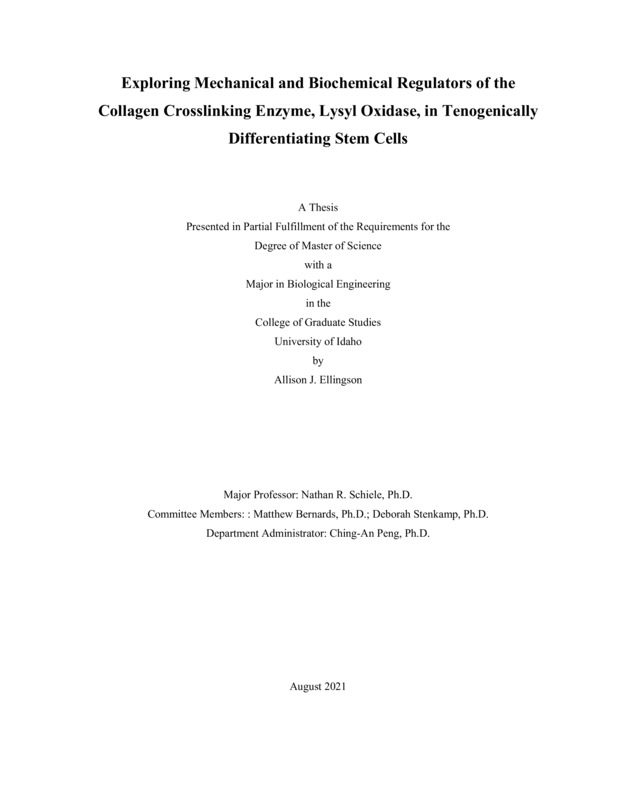Exploring mechanical and biochemical regulators of the collagen crosslinking enzyme, lysyl oxidase, in tenogenically differentiating Stem cells
Ellingson, Allison Jane. (2021-08). Exploring mechanical and biochemical regulators of the collagen crosslinking enzyme, lysyl oxidase, in tenogenically differentiating Stem cells. Theses and Dissertations Collection, University of Idaho Library Digital Collections. https://www.lib.uidaho.edu/digital/etd/items/ellingson_idaho_0089n_12177.html
- Title:
- Exploring mechanical and biochemical regulators of the collagen crosslinking enzyme, lysyl oxidase, in tenogenically differentiating Stem cells
- Author:
- Ellingson, Allison Jane
- Date:
- 2021-08
- Embargo Remove Date:
- 2022-01-07
- Keywords:
- crosslinking LOX lysyl oxidase tendon tenogenesis
- Program:
- Biological & Agricultural Engineering
- Subject Category:
- Bioengineering
- Abstract:
-
Collagen crosslinking impacts normal tendon mechanics. This thesis first reviews the major types of collagen crosslinks found in tendon (enzymatic crosslinking and non-enzymatic), and their contributions to tendon mechanical properties, as well as their mechanisms of formation. Enzymatic crosslinking that occurs during normal development is mediated by the enzyme lysyl oxidase (LOX), which plays a role in collagen matrix stiffening and strain attenuation in tendon mechanical loading. However, the cellular mechanisms regulating LOX production remain largely unknown. Several possible regulators of LOX have been identified, and experiments were conducted to, explore transforming growth factor (TGF)β2, hypoxia-inducible factor (HIF)-1α, and mechanical stimuli through applied shear stress as potential LOX regulators in mesenchymal stem cells (MSCs). TGFβ2 significantly upregulated both LOX and HIF-1α in MSCs, suggesting that, in addition to inducing tenogenesis, TGFβ2 may play a role in regulation of enzymatic crosslinking. Although hypoxic environments have been shown to upregulate LOX, HIF-1α, a transcription factor that occurs in hypoxia, does not have any significant effects on LOX, although it is upregulated in early TGFβ2-induced tenogenesis. Shear stress applied at 25 mPa did not impact LOX production, although it may be explained by magnitude-dependent regulation. A different level of mechanical stimuli, perhaps one that imitates loading experienced physiologically, could induce LOX, as seen in previous studies using different levels of stress. Other types of collagen crosslinking that occur include nonenzymatic crosslinking, or advanced glycation endproducts (AGEs) and might also be worth exploring in future studies. Due to the slow turnover of collagen, free glucose reacts to form collagen crosslinks between amino acids in the collagen fibrils. This occurs over time during the aging process, but much more quickly in hyperglycemic environments like those seen in diabetes. AGEs typically contribute to tissue stiffening and can be detrimental to tissue healing. Overall, collagen crosslinking is critical for tendon formation and homeostasis. Our results suggest that TGFβ2 may play a role in regulating enzymatic crosslinking by MSCs, and these findings could be used in future studies to improve tendon mechanical properties and advance regenerative medicine.
- Description:
- masters, M.S., Biological & Agricultural Engineering -- University of Idaho - College of Graduate Studies, 2021-08
- Major Professor:
- Scheile, Nathan R
- Committee:
- Stenkamp, Debora L; Bernards, Matthew
- Defense Date:
- 2021-08
- Identifier:
- Ellingson_idaho_0089N_12177
- Type:
- Text
- Format Original:
- Format:
- application/pdf
- Rights:
- In Copyright - Educational Use Permitted. For more information, please contact University of Idaho Library Special Collections and Archives Department at libspec@uidaho.edu.
- Standardized Rights:
- http://rightsstatements.org/vocab/InC-EDU/1.0/

